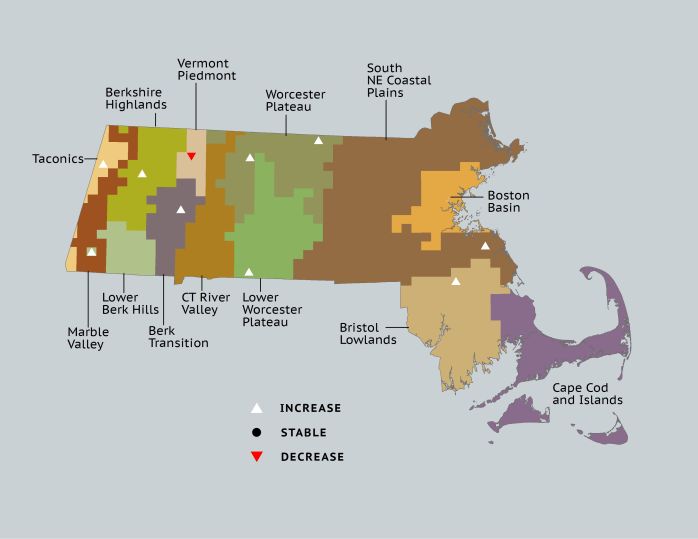Breeding Bird Atlases (BBA)
Find a Bird
Cerulean Warbler
Dendroica cerulea

Very local and strongly increasing
“Mister blue sky, please tell us why / You had to hide away / For so long (so long), where did we go wrong?” – Jeff Lynne, “Mr. Blue Sky”
With its blue-and-white plumage and dainty frame, the Cerulean Warbler resembles a piece of living sky as it forages through the treetops. This bird’s fondness for the canopy heights, as well as its rarity in the state, makes it one of the most difficult breeding warblers to find and observe. After a long period of tantalizing appearances, Cerulean Warblers finally seem to be in the process of colonizing Massachusetts from their home in the southern US. This is notable for several reasons, especially in light of recent declines for this species due to habitat destruction near the heart of their US distribution (Hamel 2000).
Historic Status
The first positively identified Cerulean Warbler in Massachusetts, a definite straggler, was found in a museum collection. In perusing the mounted birds of the Bryant Collection at the Museum of Comparative Zoology, R. H. Howe, Jr., found a single female Cerulean shot in Cohasset in 1874 (Howe & Allen 1901). Rare single sightings became the norm for this species in Massachusetts for the next century.
Atlas 1 Distribution
A lone male dutifully singing his heart out was the only sign of Possible breeding for this species during Atlas 1. The appearance of unmated Cerulean Warblers was a rare but regular phenomenon in Massachusetts for several decades by the time of Atlas 1, despite their dwindling numbers across much of their southern range. The Vermont Piedmont record may have been the only Cerulean Warbler singing the blues during Atlas 1, but the species became a bona fide state breeder just a decade later, when adult Cerulean Warblers were observed feeding young at Quabbin Reservoir in 1989 (Veit & Petersen 1993).
Atlas 2 Distribution and Change
During Atlas 2, Massachusetts was one of the few places in the country that seemed to boast an increasing breeding population of Cerulean Warblers, although this vanguard was admittedly modest. Their 14 occupied blocks were widely scattered from the Taconic Mountains to the Bristol/Narragansett Lowlands, though there was a small aggregation near the Quabbin Reservoir area in the center of the state. With four Confirmed instances of breeding and just as many Probable sites, it seems Cerulean Warblers are establishing a small breeding population in the Bay State. If this vanguard is dependent on an excess from a “source” population being furnished from our south, this advance may not hold out over time, although the increase in occurrences in the state is good news considering the species’ declining status in many other states.
Atlas 1 Map

Atlas 2 Map

Atlas Change Map

Ecoregion Data
Atlas 1 | Atlas 2 | Change | ||||||
Ecoregion | # Blocks | % Blocks | % of Range | # Blocks | % Blocks | % of Range | Change in # Blocks | Change in % Blocks |
Taconic Mountains | 0 | 0.0 | 0.0 | 1 | 4.0 | 7.1 | 1 | 6.7 |
Marble Valleys/Housatonic Valley | 0 | 0.0 | 0.0 | 0 | 0.0 | 0.0 | 0 | 0.0 |
Berkshire Highlands | 0 | 0.0 | 0.0 | 1 | 1.8 | 7.1 | 1 | 1.9 |
Lower Berkshire Hills | 0 | 0.0 | 0.0 | 1 | 3.2 | 7.1 | 1 | 3.7 |
Vermont Piedmont | 1 | 5.9 | 100.0 | 1 | 5.9 | 7.1 | -1 | -8.3 |
Berkshire Transition | 0 | 0.0 | 0.0 | 1 | 2.5 | 7.1 | 1 | 3.2 |
Connecticut River Valley | 0 | 0.0 | 0.0 | 1 | 1.5 | 7.1 | 0 | 0.0 |
Worcester Plateau | 0 | 0.0 | 0.0 | 3 | 3.4 | 21.4 | 2 | 4.2 |
Lower Worcester Plateau | 0 | 0.0 | 0.0 | 3 | 3.8 | 21.4 | 1 | 1.9 |
S. New England Coastal Plains and Hills | 0 | 0.0 | 0.0 | 1 | 0.4 | 7.1 | 1 | 0.4 |
Boston Basin | 0 | 0.0 | 0.0 | 0 | 0.0 | 0.0 | 0 | 0.0 |
Bristol and Narragansett Lowlands | 0 | 0.0 | 0.0 | 1 | 0.9 | 7.1 | 1 | 1.0 |
Cape Cod and Islands | 0 | 0.0 | 0.0 | 0 | 0.0 | 0.0 | 0 | 0.0 |
Statewide Total | 1 | 0.1 | 100.0 | 14 | 1.4 | 100.0 | 8 | 1.0 |
Notes
The Cerulean Warbler shows a significant decreasing Breeding Bird Survey trend in the Eastern US overall.



